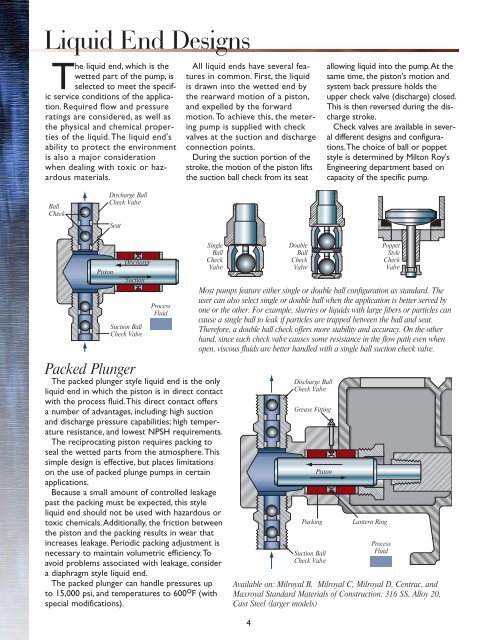Metering Pump Technology - Fine Line Instrument
Metering Pump Technology - Fine Line Instrument
Metering Pump Technology - Fine Line Instrument
Create successful ePaper yourself
Turn your PDF publications into a flip-book with our unique Google optimized e-Paper software.
Liquid End Designs<br />
The liquid end, which is the<br />
wetted part of the pump, is<br />
selected to meet the specific<br />
service conditions of the application.<br />
Required flow and pressure<br />
ratings are considered, as well as<br />
the physical and chemical properties<br />
of the liquid.The liquid end's<br />
ability to protect the environment<br />
is also a major consideration<br />
when dealing with toxic or hazardous<br />
materials.<br />
Ball<br />
Check<br />
Piston<br />
Discharge Ball<br />
Check Valve<br />
Seat<br />
Discharge<br />
Suction<br />
Suction Ball<br />
Check Valve<br />
Process<br />
Fluid<br />
All liquid ends have several features<br />
in common. First, the liquid<br />
is drawn into the wetted end by<br />
the rearward motion of a piston,<br />
and expelled by the forward<br />
motion.To achieve this, the metering<br />
pump is supplied with check<br />
valves at the suction and discharge<br />
connection points.<br />
During the suction portion of the<br />
stroke, the motion of the piston lifts<br />
the suction ball check from its seat<br />
Single<br />
Ball<br />
Check<br />
Valve<br />
Packed Plunger<br />
The packed plunger style liquid end is the only<br />
liquid end in which the piston is in direct contact<br />
with the process fluid.This direct contact offers<br />
a number of advantages, including: high suction<br />
and discharge pressure capabilities; high temperature<br />
resistance, and lowest NPSH requirements.<br />
The reciprocating piston requires packing to<br />
seal the wetted parts from the atmosphere.This<br />
simple design is effective, but places limitations<br />
on the use of packed plunge pumps in certain<br />
applications.<br />
Because a small amount of controlled leakage<br />
past the packing must be expected, this style<br />
liquid end should not be used with hazardous or<br />
toxic chemicals.Additionally, the friction between<br />
the piston and the packing results in wear that<br />
increases leakage. Periodic packing adjustment is<br />
necessary to maintain volumetric efficiency.To<br />
avoid problems associated with leakage, consider<br />
a diaphragm style liquid end.<br />
The packed plunger can handle pressures up<br />
to 15,000 psi, and temperatures to 600 o F (with<br />
special modifications).<br />
4<br />
Double<br />
Ball<br />
Check<br />
Valve<br />
allowing liquid into the pump.At the<br />
same time, the piston's motion and<br />
system back pressure holds the<br />
upper check valve (discharge) closed.<br />
This is then reversed during the discharge<br />
stroke.<br />
Check valves are available in several<br />
different designs and configurations.The<br />
choice of ball or poppet<br />
style is determined by Milton Roy's<br />
Engineering department based on<br />
capacity of the specific pump.<br />
Poppet<br />
Style<br />
Check<br />
Valve<br />
Most pumps feature either single or double ball configuration as standard. The<br />
user can also select single or double ball when the application is better served by<br />
one or the other. For example, slurries or liquids with large fibers or particles can<br />
cause a single ball to leak if particles are trapped between the ball and seat.<br />
Therefore, a double ball check offers more stability and accuracy. On the other<br />
hand, since each check valve causes some resistance in the flow path even when<br />
open, viscous fluids are better handled with a single ball suction check valve.<br />
Discharge Ball<br />
Check Valve<br />
Grease Fitting<br />
Piston<br />
Packing Lantern Ring<br />
Suction Ball<br />
Check Valve<br />
Process<br />
Fluid<br />
Available on: Milroyal B, Milroyal C, Milroyal D, Centrac, and<br />
Maxroyal Standard Materials of Construction: 316 SS, Alloy 20,<br />
Cast Steel (larger models)


